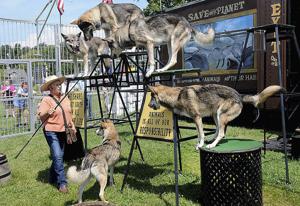Posted: Thursday, August 20, 2015
With children
learning popular stories like “The Three Little Pigs” and “Little Red
Riding Hood” at an early age, it’s no wonder wolves have gotten a bad
rep. In each story and in countless others, they are portrayed one way and one way only. They are “the big bad wolf.”
That’s
not the impression the large crowds who have filled the seats and
grassy area at the West Virginia State Fair’s Wolves of the World show
have left with, however. After
watching and listening to show owner, animal trainer, rescuer and
animal rights supporter Sharon Sandlofer and her eight wolves, audience
members have left with smiles and a newly found appreciation for the
often misunderstood animal.“I got some good information out of it,” said Tewon Turner, 17, of Sinks Grove in Monroe County. “You only hear that wolves attack people, but that’s not true. They’re really shy animals.”
The show, which offers a mix of education and entertainment, begins with general information about wolves.
Sandlofer explains to the crowd that the wolves, which live on every continent except Antarctica, have been hunted to near extinction. She then plays a brief audio clip explaining the important role wolves play in the ecosystem and the positive results seen in Yellowstone National Park since they were reintroduced in 1995.
Since the reintroduction, vegetation and forests in Yellowstone have regenerated rapidly as the deer population has decreased and rerouted; birds, beaver, hawks and eagles have moved in and the rivers have begun meandering less due to less soil erosion.“They play a very important part in our ecosystem,” Sandlofer said. “God put them here for a purpose and they serve it quite well.”
As the audience listens to the information, they have a clear line of vision to the main attraction — the wolves, mostly patiently waiting inside cages in a trailer behind the secure gated show area.
Sandlofer introduces alpha female Lakota, 12, and alpha male Zephyr, 4.
She points out the rounded ears, which keep the animals cool on cold, winter nights, a long snout that enables them to dig through foxholes and rabbit holes, beautiful yellow golden eyes, long legs and big feet.
“If you look at wolves up close, you’ll see that their two center toes are longer than the others,” Sandlofer said. “That gives them better traction when they’re on the hunt.”
A pack consists of anywhere from five to 20 wolves, but only the alpha male and female mate. Sandlofer says three weeks after pups are born, the alpha female introduces them to the pack, and they are then cared for by all.
“They’re really amazing animals,” she said.
Back in the trailer, another group of wolves wait their turn at stardom, but Sandlofer first secures Lakota and Zephyr, as she says they want nothing to do with the “babies.”
It turns out the babies are five, 3-year-old wolf hybrids born in West Virginia. Yukon, Alaska, Klondike, Keno and Juno are 98 percent Eastern Timberwolf and 2 percent Alaskan Malamute — the curled up tail is the hybrid giveaway. “The boys” as Sandlofer calls them, are a rowdy bunch who roll in the grass, play in water and steal her treats — raw meat — but also know exactly where they are supposed to be.
“You don’t train wolves,” she said. “They’re very independent. We try to find things they like to do and hope they do it when we ask them. It doesn’t always work that way, but the treat at the end is a pretty good incentive.”
Following the show, Sandlofer offers audience members an opportunity to hold and have their photos taken with a wolf pup.
“It was very fun to actually take a picture with a wild wolf,” said Avery Miller, 8, of Organ Cave. “It didn’t scare me at all.” “It was fun and soft,” added her 6-year-old brother Hudson. “And he bit me a little.” “Did he nibble you?” his mom Ashley corrected. “He licked me,” Avery said.
• • •
Every wolf in the show is a rescue, as Sandlofer said she has been involved in rescue work for more than 40 years.
She and her husband Michael, who is missing the fair while receiving treatment for cancer, have done other shows with black bears and mountain lions, but became involved with wolves about 10 years ago. “I had no idea how many needed help and what the story was with the wolf,” she said.
“They’re really such amazing animals, and when we researched it and found out about the project at Yellowstone Park and how important they are to our ecosystem, it just kind of went from there and that’s how the show developed.”
The Sandlofers and their dogs, two herding dogs and a rescue, of course, travel 6 to 8 months of the year, educating the public about wolves and encouraging them to contact their local congressman or woman and ask that they be put back on the protected list.
She said she is enjoying the fair and encourages people to stop by the show, which takes place daily at noon, 2:30 p.m. and 5 p.m.“I think people should really come out and learn about the wolves,” she said. “They’re really important animals.”
source



No comments:
Post a Comment